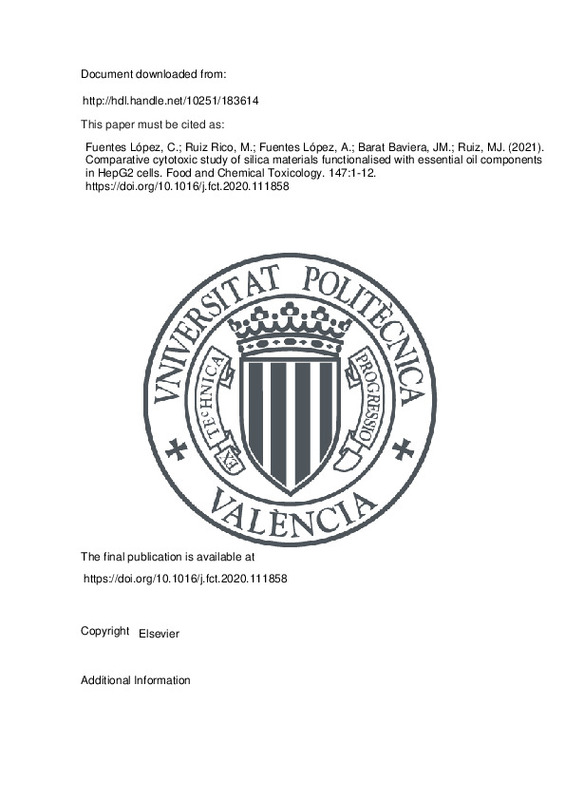JavaScript is disabled for your browser. Some features of this site may not work without it.
Buscar en RiuNet
Listar
Mi cuenta
Estadísticas
Ayuda RiuNet
Admin. UPV
Comparative cytotoxic study of silica materials functionalised with essential oil components in HepG2 cells
Mostrar el registro sencillo del ítem
Ficheros en el ítem
| dc.contributor.author | Fuentes López, Cristina
|
es_ES |
| dc.contributor.author | Ruiz Rico, María
|
es_ES |
| dc.contributor.author | Fuentes López, Ana
|
es_ES |
| dc.contributor.author | Barat Baviera, José Manuel
|
es_ES |
| dc.contributor.author | Ruiz, María José
|
es_ES |
| dc.date.accessioned | 2022-06-27T18:06:29Z | |
| dc.date.available | 2022-06-27T18:06:29Z | |
| dc.date.issued | 2021-01 | es_ES |
| dc.identifier.issn | 0278-6915 | es_ES |
| dc.identifier.uri | http://hdl.handle.net/10251/183614 | |
| dc.description.abstract | [EN] This work evaluated the cytotoxic effect of different EOCs-functionalised silica particle types. The in vitro toxicity of eugenol and vanillin-immobilised SAS, MCM-41 microparticles and MCM-41 nanoparticles was evaluated on HepG2 cells, and compared to free EOCs and pristine materials. The results revealed that free essential oil components and bare silica had a mild cytotoxic effect on HepG2 cells. However, the comparative study showed that free eugenol and vanillin had a milder cytotoxic effect than the equivalent concentrations of immobilised components on the different silica particles, while differences in cell viability between the bare and functionalised particles relied on the type of analysed material. The most cytotoxic materials were eugenol and vanillin-functionalised MCM-41 micro with IC50 values of 0.19 and 0.17 mg/mL, respectively, at 48 h exposure. Differences in cytotoxicity between functionalised particles may be attributed to the density of the functional components on their surface as a result of the functionalisation reaction performance for different materials. The study of the physico-chemical properties of particles demonstrated that cationic nature and increased hydrophobicity could be responsible for promoting cell-particle interactions for the eugenol and vanillin functionalised silica particles, enhancing their cytotoxic behaviour. | es_ES |
| dc.description.sponsorship | The authors gratefully acknowledge the financial support from the Spanish government (Project RTI2018-101599-B-C21 (MCUI/AEI/FEDER, EU)). C.F. thanks the Generalitat Valenciana for being funded by the predoctoral programme Vali+d (ACIF/2016/139). M.R.R. also acknowledges the Generalitat Valenciana for her postdoctoral fellowship (APOSTD/2019/118). | es_ES |
| dc.language | Inglés | es_ES |
| dc.publisher | Elsevier | es_ES |
| dc.relation.ispartof | Food and Chemical Toxicology | es_ES |
| dc.rights | Reconocimiento - No comercial - Sin obra derivada (by-nc-nd) | es_ES |
| dc.subject | MCM-41 | es_ES |
| dc.subject | Silica | es_ES |
| dc.subject | Eugenol | es_ES |
| dc.subject | Vanillin | es_ES |
| dc.subject | Cytotoxicity | es_ES |
| dc.subject | HepG2 | es_ES |
| dc.subject.classification | TECNOLOGIA DE ALIMENTOS | es_ES |
| dc.title | Comparative cytotoxic study of silica materials functionalised with essential oil components in HepG2 cells | es_ES |
| dc.type | Artículo | es_ES |
| dc.identifier.doi | 10.1016/j.fct.2020.111858 | es_ES |
| dc.relation.projectID | info:eu-repo/grantAgreement/AEI/Plan Estatal de Investigación Científica y Técnica y de Innovación 2017-2020/RTI2018-101599-B-C21/ES/DESARROLLO Y APLICACION DE SISTEMAS ANTIMICROBIANOS PARA LA INDUSTRIA ALIMENTARIA BASADOS EN SUPERFICIES FUNCIONALIZADAS Y SISTEMAS DE LIBERACION CONTROLADA/ | es_ES |
| dc.relation.projectID | info:eu-repo/grantAgreement/GVA//APOSTD%2F2019%2F118//CONTRATO POSDOCTORAL GVA-RUIZ RICO. PROYECTO: DESARROLLO DE NUEVOS SISTEMAS ANTIMICROBIANOS / | es_ES |
| dc.relation.projectID | info:eu-repo/grantAgreement/GVA//ACIF%2F2016%2F139//AYUDA CONSELLERIA PARA LA CONTRATACION DE PERSONAL INVESTIGADOR PREDOCTORAL-FUENTES LOPEZ (EVALUACION DE TOXICIDAD DE SOPORTES BIOCOMPATIBLES)/ | es_ES |
| dc.rights.accessRights | Abierto | es_ES |
| dc.contributor.affiliation | Universitat Politècnica de València. Departamento de Tecnología de Alimentos - Departament de Tecnologia d'Aliments | es_ES |
| dc.description.bibliographicCitation | Fuentes López, C.; Ruiz Rico, M.; Fuentes López, A.; Barat Baviera, JM.; Ruiz, MJ. (2021). Comparative cytotoxic study of silica materials functionalised with essential oil components in HepG2 cells. Food and Chemical Toxicology. 147:1-12. https://doi.org/10.1016/j.fct.2020.111858 | es_ES |
| dc.description.accrualMethod | S | es_ES |
| dc.relation.publisherversion | https://doi.org/10.1016/j.fct.2020.111858 | es_ES |
| dc.description.upvformatpinicio | 1 | es_ES |
| dc.description.upvformatpfin | 12 | es_ES |
| dc.type.version | info:eu-repo/semantics/publishedVersion | es_ES |
| dc.description.volume | 147 | es_ES |
| dc.identifier.pmid | 33212212 | es_ES |
| dc.relation.pasarela | S\424890 | es_ES |
| dc.contributor.funder | Generalitat Valenciana | es_ES |
| dc.contributor.funder | AGENCIA ESTATAL DE INVESTIGACION | es_ES |
| dc.contributor.funder | European Regional Development Fund | es_ES |







![[Cerrado]](/themes/UPV/images/candado.png)

